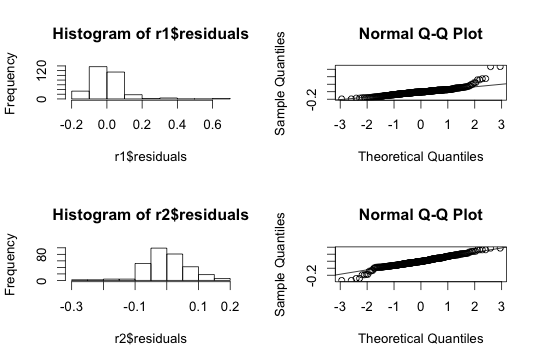Here is a summary of my actual data
> summary(data_licor_sub)
Date Block Tree.ID Cross Rank Log.ID
Fri Aug 29 2014:24 1:96 17578 : 32 180-1 x MAX1 :56 short:160 Min. : 1.00
Thr Aug 28 2014:80 2:94 17786 : 32 288-5 x MAX3 :46 tall :150 1st Qu.:18.00
Tue Aug 26 2014:80 3:96 17844 : 32 D125 x K1 :64 Median :36.00
Tue Sep 2 2014:40 4:24 17544 : 24 SO443WL x SO479WL:48 Mean :38.35
Wed Aug 27 2014:86 17757 : 24 SO450WL x SO465WL:48 3rd Qu.:57.75
17961 : 24 SO459WL x SO469WL:48 Max. :86.00
(Other):142
HHMMSS FTime EBal. Photo Cond Temp.group
10:10:12: 1 Min. : 275.5 Min. :0 Min. :-9.905 Min. :0.07728 30:154
10:10:15: 1 1st Qu.: 6102.2 1st Qu.:0 1st Qu.:-5.320 1st Qu.:0.17907 35:156
10:12:51: 1 Median : 9855.5 Median :0 Median :11.233 Median :0.23381
10:12:54: 1 Mean : 9529.0 Mean :0 Mean : 7.545 Mean :0.26349
10:26:29: 1 3rd Qu.:13077.2 3rd Qu.:0 3rd Qu.:19.671 3rd Qu.:0.31512
10:26:32: 1 Max. :18499.0 Max. :0 Max. :28.378 Max. :1.01373
(Other) :304
Tair Tleaf Light.Dark Cond.log
Min. :26.40 Min. :28.18 Dark :154 Min. :-3.69372
1st Qu.:29.54 1st Qu.:29.46 Light:156 1st Qu.:-2.48140
Median :35.28 Median :31.96 Median :-2.09658
Mean :34.64 Mean :32.14 Mean :-2.07202
3rd Qu.:39.23 3rd Qu.:34.90 3rd Qu.:-1.66605
Max. :41.57 Max. :36.11 Max. : 0.01967
Basically i am interested to see how the photosynthesis & conductance (respiration) varies for genotype (Tree.ID), family (Cross), height (Rank) and temperature (Temp.group).
Before doing any analysis, i tried to check for normality of my two variable (Photo/Cond), i found that they are not normal (i am only showing "Cond" here) and because of that i have decided to transform that data using Box-cox transformation. Even though the transformation worked really well, it changed my anova result.
Here is my initial anova regression result
> r1 <- aov(Cond ~ Temp.group + Cross + Rank + Tree.ID, data_licor_sub)
> summary(r1)
Df Sum Sq Mean Sq F value Pr(>F)
Temp.group 1 0.3971 0.3971 39.755 1.04e-09 ***
Cross 5 1.1798 0.2360 23.624 < 2e-16 ***
Rank 1 0.0082 0.0082 0.824 0.365
Tree.ID 5 0.7318 0.1464 14.653 7.61e-13 ***
Residuals 297 2.9665 0.0100
However after transforming the box-cox transformation using an appropriate lambda, this is what i get
> r2 <- aov(Cond^-0.18181818 ~ Temp.group + Cross + Rank + Tree.ID, data_licor_sub)
> summary(r2)
Df Sum Sq Mean Sq F value Pr(>F)
Temp.group 1 0.3106 0.31063 59.045 2.26e-13 ***
Cross 5 1.1012 0.22023 41.863 < 2e-16 ***
Rank 1 0.0324 0.03237 6.153 0.0137 *
Tree.ID 5 0.4203 0.08406 15.978 6.05e-14 ***
Residuals 297 1.5625 0.00526
As you can see the variable "Rank" was non significant before but now it became significant after transformation. Am i missing some thing?
Here is a plot that shows before and after transformation to indicate the transformation worked great

I also did log-transformation based on comment from one of the person and here is the result. Looks more or less same as box-cox transformation.
> r3 <- aov(Cond.log ~ Temp.group + Cross + Rank + Tree.ID, data_licor_sub)
> summary(r3)
Df Sum Sq Mean Sq F value Pr(>F)
Temp.group 1 11.52 11.520 57.802 3.83e-13 ***
Cross 5 40.30 8.061 40.444 < 2e-16 ***
Rank 1 1.08 1.082 5.427 0.0205 *
Tree.ID 5 16.34 3.269 16.401 2.71e-14 ***
Residuals 297 59.19 0.199

